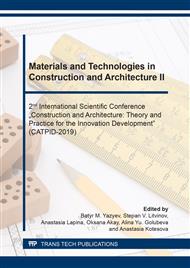[1]
Nesvetaev G.V. Concretes: a textbook, Rostov on Don, Phoenix, (2011).
Google Scholar
[2]
Akhmatov M.A., Lightweight concrete and reinforced concrete structures on aggregates of stone waste and loose porous rocks, Nalchik, KBGSHA, (2010).
Google Scholar
[3]
V.K Khuranov, A.S. Tsipinov, М.I. Bjakhov Wall Panels with Improved Thermal Properties on KBR's Porous Fillers Materials Science Forum. 931 (2018) 243-246.
DOI: 10.4028/www.scientific.net/msf.931.243
Google Scholar
[4]
Karpenko N.I., Yarmakovsky V.N. The main directions of energy saving in the construction and operation of buildings. Part 1. Resource and energy saving at the stage of production of building materials, wall products and enclosing structures, Construction materials. 7 (2013) 12–21.
Google Scholar
[5]
Bzhakhov M.I., Kardanov L.T., Kuchukov M.A., Antipova E.A., Lyuev A.Kh., Improving the heat-shielding qualities of the external enclosing structure of a dwelling house of a type series, Engineering Bulletin of the Don. 2 (2016). Information on: ivdon.ru/ru/magazine/archive/ n2y2016/3544.
Google Scholar
[6]
GOST 25820-2014 Light concrete. Technical conditions.
Google Scholar
[7]
SNiP ΙΙ-3-79 * Construction Heat Engineering.
Google Scholar
[8]
SNiP 23-01-99 Construction climatology.
Google Scholar
[9]
SNiP 2.08.01-89 * Residential buildings (with change No. 1-4).
Google Scholar
[10]
Physics of the environment, Textbook, DIA, Moscow, (2011).
Google Scholar
[11]
Yeremkin A.I., Koroleva T.I., Thermal Mode of Buildings. Tutorial, Publishing house DIA, Moscow, (2000).
Google Scholar
[12]
Belyaev V.S., Akhmyarov T.A., Energy efficiency of large-panel buildings, Housing construction. 4 (2013) 47–49.
Google Scholar
[13]
Dovzhik V.G., Calculation and rationing of thermal conductivity of claydite-concrete and other types of concrete, Concrete and reinforced concrete. 5 (2007) 15-19.
Google Scholar
[14]
Kosmatka S., Kerkoff B., Hooton R., Design and control of Concrete Mixtures. The Guide to Application, Methods and Materials. Eight Canadian Edition, Cement Association of Canada. Ottawa, (2011).
Google Scholar
[15]
Ivanov I.A., Technology of lightweight concrete on artificial porous aggregates, Stroiizdat, Moscow, (1974).
Google Scholar
[16]
Szokolay S.V., Environmental science handbook for architects and builders Lancaster, Construction Press, (1980).
Google Scholar


